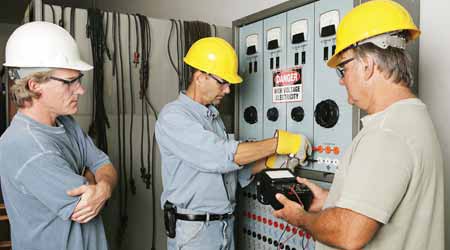Arc-Flash Safety: Assessing Electrical Equipment
Part two of a two part series on arc-flashes
A closer look at labels
Arc-flash risk assessments can help managers and technicians identify electrical equipment that requires labeling. NFPA 70E requires employers field-mark electrical equipment as part of the arc-flash risk assessment. Technicians must field-mark electrical equipment such as switchboards, panelboards, industrial control panels, meter-socket enclosures, and motor control centers, that are not in dwelling units and that are likely to require examination, adjustment, servicing, or maintenance while energized. The labels must contain the following information:
• nominal system voltage
• arc-flash boundary
• at least one of the following: available incident energy and the corresponding working distance or the arc-flash PPE category; minimum arc rating of clothing; or site specific level of PPE.
Technicians can make the labels in-house with custom software or purchase them through vendors.
PPE selection
During an arc-flash, daily clothing would do little to protect technicians from serious injury. At such high temperatures, clothing will ignite and continue to burn on the body well after the arc-flash has dissipated. In areas where employees can encounter potential electrical hazards, employers must provide and ensure technicians use PPE that is appropriate for the specific parts of the body to be protected for the type of electrical work to be performed. According to OSHA’s general industry standard 1910.335(a)(1)(i)], PPE can include:
• body protection using flame resistant clothing with an arc rating or arc thermal performance value
• protection using helmets as specified by ANSI Z89.1
• eye and face protection as specified by ANSI Z87.1
• hand protection using gloves as specified by ASTM D 120-02 and F 496 standards.
Other protective equipment can include arc-suppression blankets and insulated tools.
The 2015 edition of NFPA 70E includes revised detailed tables for arc-flash hazard identification and arc-flash PPE categories. These tables identify specific levels of PPE for various types of hazards and ratings of electrical equipment. Special PPE might not be necessary for certain tasks where the risk of an arc-flash or shock hazard are low, such as the normal operation of properly installed and maintained equipment.
Jeffery C. Camplin, CSP, CPEA, CET — mundycamp@aol.com — is president of Camplin Environmental Services, a safety and environmental consulting firm in Rosemont, Ill.
Related Topics:













